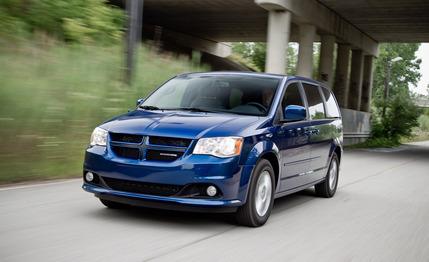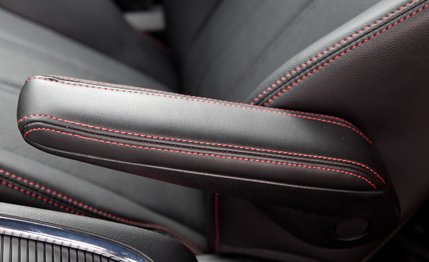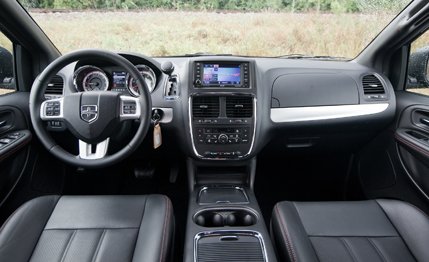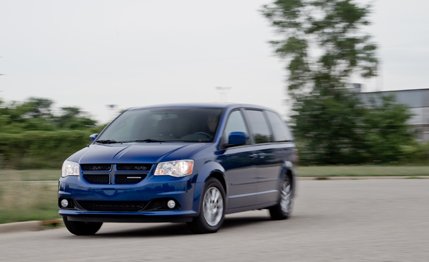 Short Take Road Test
Short Take Road Test

Yes, it’s a minivan. But it’s a minivan with an interesting distinction: It wears an R/T badge, signifying membership in Chrysler’s Road and Track performance fraternity. One of four new R/T treatments at last February’s Chicago auto show, this Grand Caravan was initially greeted with polite skepticism. But when Ralph Gilles, erstwhile Dodge design chief and now head of all things SRT, revealed that his product planners were calling it the “man van,” polite skepticism gave way to outright mirth. You won’t see the phrase “man van” in any formal marketing messages.
But once we’d grappled with the incongruity of the notion—manliness and minivans are concepts that don’t willingly juxtapose—we could see the underlying logic. After all, who drives minivans? Parents, many of them unwillingly—they’d rather be driving an SUV. But when families reach a certain size, there is no more rational all-around tribe hauler than a minivan. For those who acknowledge this fact, the bottom line is that a guy is going to be driving the minivan at least some of the time. The idea of the man van is to make that guy feel as good as possible about doing so.
Like previous R/T minivans, this one’s manliness is rooted primarily in cosmetics. On the outside, that includes a body-color grille and side moldings, unique 17-by-6.5-inch aluminum wheels, and a new front spoiler. The interior color scheme is macho black, nicely highlighted by red stitching. The comfortable and supportive power-adjustable front seats are clad in perforated leather, and the shift knob, which juts out of the dashboard, also wears the hide of a former cow, as does the steering wheel.
Hard-Working Man Van
So, definite distinctions in panache (a word rarely used in minivan descriptions). But to the credit of the Gilles group, there’s a little substance to go with the style, thus setting this R/T minivan apart from previous versions. This applies specifically to roll stiffness. The R/T team prescribed modest spring-rate increases in 2011 models and then, feeling they’d been a little too cautious, more dramatic increases for 2012, particularly at the front. They also decreased the front anti-roll-bar diameter, from 28 mm to 27, and installed auxiliary front springs that come into play when the van is loaded, again for increased roll stiffness.

What this adds up to is a level of overall transient response that’s a little quicker than that of the standard Grand Caravan, as well as flatter cornering attitudes. Add these to steering that was already best in class, and you have a minivan with elevated testosterone levels when the road gets a little kinky and the driver wants some fancy footwork.
That’s the upside. The downside is that the Grand Caravan is among the porkiest—at 4694 pounds—of the current minivan crop, never a dynamic asset and a factor that inevitably shows up in the 0-to-60 derby. Despite the stoutest engine among current minivans—283 hp and 260 lb-ft of torque—the Grand Caravan’s acceleration numbers are somewhere between ho and hum: 7.9 seconds to 60, 16.2 seconds at 86 mph in the quarter. Not very R/T. And the stiffer suspension tuning is diluted by low-rolling-resistance all-season rubber, which holds the man van to 0.77 g on the skidpad and contributes to indifferent braking performance: 189 feet from 70 mph. We recently subjected ourselves to a minivan comparison test in which those figures would have landed the R/T in last place on the skidpad and second to last in the braking test.
Although the suspension upgrades are negated by the tire choice, Gilles and crew deserve a gold star or two for trying to add a dollop of drama to a vehicle that is simultaneously the zenith of practicality and the nadir of sexiness. The tires are obviously a concession to autodom’s obsessive preoccupation with efficiency (the EPA ratings are 17 mpg city/25 highway; our average was 20 mpg). But at least there’s a slightly livelier feel to the van’s behavior and no real penalty in ride quality, although the stiffer suspension does magnify the excessive flexibility of this chassis. Still, we think Dodge should install this package on all Grand Caravans. Then the R/T version could be differentiated by Penske remote reservoir shocks and a seam-welded chassis. Then again, maybe not.
Inside Man Van
The interior looks good and feels better, and of course there’s the usual array of infotainment features, including family-peacekeeping options like the second row’s nine-inch video screen with wireless headphones and remote controls. In fact, even though it wears the R/T badge, the man van is actually the new lux leader for the Grand Caravan lineup. And it might just be that a product designation reflecting that status—luxury rather than manliness—would make van men at least as happy, if not more so.

Pricing for the 2012 Grand Caravan starts at $23,830; the R/T starts at $30,830. Our man-van sample included a media center ($1360), the Entertainment Group ($795), and the Driver Convenience Group ($795), elevating the as-tested total to $33,780. In the world of minivans, that’s a bargain—consider that only one of the Honda Odyssey’s seven trim levels starts below the R/T’s base price.
One final note: If you find the man-van stuff to be a little silly, consider an earlier Chrysler Corporation foray into gender-specific marketing, That would be the 1955 Dodge LaFemme, a version of the Custom Royal Lancer distinguished by a pink (Heather Rose) and white exterior, tapestry upholstery with pink rosebuds, and a pink calfskin purse.
Dodge brochures dedicated the car to “Her Royal Highness the American Woman.”
Now that was silly.
